A Basic and Adaptable Queen of Hungary Water Recipe

Friends, I have gone too long missing my favorite botanical toner because I’ve been out of a key toner ingredient: Queen of Hungary Water. In this article I am going to share a little about what this is, and a super basic and adaptable Queen of Hungary Water recipe you can try at home.
I don’t do a lot to my face. This is no confession – it’s pretty obvious I’m minimum maintenance.
I *might* wash my face in my bi-weekly hair washing shower (yeah, I’m not really into doing a lot with my hair, either, you can see a trend here).
I wear make up about 4 times a year – if I am having my picture taken or going out to an event or on a date.
As a young teen I was an early adopter of fashion and personal style. I was more into make-up when I was 13 than for the rest of my life combined.
In my 20’s I didn’t have any makeup. Not a single bit. Well, maybe a tinted lip gloss. I finally bought eyeliner and mascara (and a lot of hairspray) when I was Jackie O for Halloween.
Just yesterday I confessed to a friend that it’s time for me to invest in new makeup but – shock – I really don’t want to. My lotion-foundation is 10 years old now (that can’t be good?), and because I bought it in the month of December I can’t wear it in the summer because it’s a couple shades too light.
So you can see that something must be really good for me to take the time to do it when it comes to my skin care routine.
One of the few things I do do to my face is use Hypericum oil (aka St. John’s Wort) in the morning as a moisturizer and sun protector.
In the not so distant past, however, I used a homemade botanical toner in the morning. And I loved it. Really loved it.
I’ve been out of my favorite handmade botanical toner for a few months now, and I really miss it. Essentially, it was the only thing I really liked to do as part as my regular skin tending.
I loved the smell of all of the herbs in the botanical toner. How makes my face feel hydrated and soothed as I apply it. And mostly how my skin feels even and moisturized afterwards.
And I loved the fact that I was a part of creating my own facial care product.
I have so much fun connecting with the plants that go into my creations, whether it’s a tea, an oil or a toner.


The last time I made a batch of Queen of Hungary water was in 2011. When stored in the fridge, it lasts a long time! The herbal books say it will last 3 years. Mine lasted 9. And it didn’t even go bad, I simply ran out of it.
I remembered harvesting the fresh herbs, the aromatic Lemon Balm and Rose. I remember setting intentions and giving thanks for the healing properties of the herbs while I shook the jar of herbal vinegar over the weeks as it macerated.
It is a gift to connect with the very plants who became that little bottle of toner. It’s was like a mini vacation every time I used it.
Summer 2020 is upon me and it is high time that I get down to creating another batch of botanical facial toner.
And it starts with making one of the key components – Queen of Hungary Water.
What is Queen of Hungary Water?
Let’s start with the basics – Queen of Hungary water is a not a water at all. It is an herbal vinegar preparation.
Queen of Hungary Water recipes have been floating around the herbal communities for a few decades, as far as I can tell it was first referenced in modern herbal writing by Rosemary Gladstar. It has since made its way into many other herbal book and classes about herbal body care, often with their own unique flavor from the teacher/writer. Dina Falconi’s “Earthly Bodies, Heavenly Hair” is one of my favorites.
In her herbal home study course (as well as her in-person classes), Gladstar had a section about herbal body care. This may seem common place now, but when it first came out, I imagine that it was a little bit of a divergence.
Herbalism was (and still is) more often about medicinal herbalism, and things like skin care was not talked about a lot beyond skin infection or conditions. The resurgence of herbalism in the US of the 1960’s – 1970’s picked up where the last of the medical herbalists left off in the early 1900’s: strong alcoholic extracts, mostly.
Gladstar saw that there was a little revolution held within the act of people making their own hair care and body care products with plants and natural ingredients. And it’s just as valid and important as people connecting with plants for their medicine.
This is quite brilliant. On one hand, herbal body care is a gateway into herbalism in general for people. On the other hand, for people who use herbal medicine already, possibly in a “what herb is good for X?” Western reductionist influenced way of thinking, herbal body care is a gateway into somatic, sensual embodiment.
Using herbs on our body creates a ‘nother level of being in relationship with plants.


Queen of Hungary Water Herb Options
- Chamomile
- Roman Chamomile
- Rose
- Plantain
- Comfrey
- Calendula
- Lemon Balm
- Hyssop
- Thyme
- Scented Geranium
Basic Queen of Hungary Water Recipe Directions
- Determine how much Q of H Water you’d like to make. Find a jar to accommodate your desired outcome.
- Add herbs to the jar to fill it about halfway full. *see note about dried or fresh herbs below
- Cover the herbs with organic Apple Cider Vinegar.
- Make sure there is about 2 inches of “head space” in your jar. This means there is about 2 inches of vinegar above the level of the herbs. Often the vinegar (or alcohol, or water) will not be directly on top of the herbs but under or in between the herbs. Wherever it is, try to make it be 2 inches. You will probably have to add more vinegar a day or two later as the herbs absorb it through the steeping process.
- Shake daily or as often as you think of it.
- Strain after 6 weeks – or longer. I sometimes let herbal vinegars steep 3 months or more, mostly because I am putting off the straining process aka lazy. But technically it should be sufficiently steeped after 6 weeks.
- Bottle. Label. Store in a cool dry dark area. I often store mine in the fridge.
- To use: Pour off some Q of H water into a small bottle. Place a small amount onto a cotton ball or whatever you prefer to use to apply toner – could be your fingers. Use once or twice daily.
* Dried or fresh herbs: Which to use? I have used both, and a mixture of both. I like them all. It is up to you. Try both and see how you like it.
Wilting fresh herbs. If you have access to fresh herbs, I recommend cutting them to about 1/4 inch long and letting them wilt for 6-24 hours. Wilting allows the excess moisture to evaporate. The slightly less watery herbs extracts a more fully because there is less water that ends up in the mixture. Fresh herbs contain quite a bit of moisture, even if they don’t feel wet to the touch. You can see in the photos of the herbs in the jar how much condensation had already occurred in about 20 minuets.
A little goes a long way. In 2011, I made this recipe in a pint jar, and the yield from there, about 1 1/3 cups or 5-6 ounces, was enough to last me for 9 years. That’s because I prefer to mix Queen of Hungry Water with botanical hydrosols, aloe, and Witch Hazel to create a toner. I do not use straight Q of H Water as a toner – nothing wrong with doing so, I just so happen to like adding other ingredients in as well.
I was also making botanical toners for my herbal product line with that same 5-6 oz of Q of H Water. All this is to say that making this in a pint jar produces a good amount, and perhaps you want to start there.
Use what inspires you and what you have available. Really though, I don’t think it is necessary to follow a specific recipe. It’s more about picking herbs you’d like to slather on your face…some are known for smelling yummy and some are known for being particularly healing.
Vinegar can be drying to the skin, use as a rinse or dilute. When I make a botanical facial toner, I dilute use about half Queen of Hungary water and half hydrosols/Witch Hazel.
Ingredient Descriptions
Queen of Hungary Water is an apple cider vinegar extraction of fresh and or dried herbs that are soothing and balancing to the skin.
Some of the herbs are floral uplifters, herbs you’d know from their scents (I say that because they smell amazing and lift the spirit as you apply them close to your brains sensory centers – eyes, mouth, nose and even ears). Chamomile, Lavender and Rose, for example.
Some of the herbs are specific skin healers, herbs you’d know from wound healing like Comfrey, Plantain and Calendula.
There is great overlap between the “uplifting florals” and the “soothing skin healers” ingredients. We often categorize things because it is satisfying to the mind and helps us learn and understand the world around us. In the end, plants are complex and so are their actions.
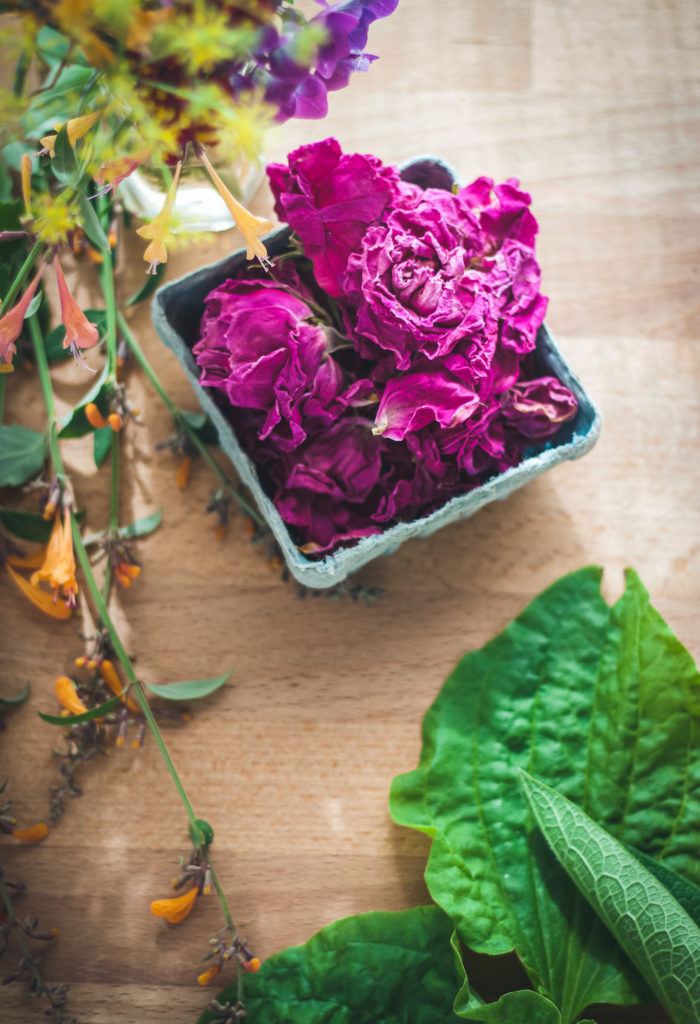

Sensual Florals
I’ve been talking a lot about Rose lately on the blog. Summer time is Rose season around here for sure!
Rose is highly floral and sensual, yes. But the red and pink pigmented Rose petals are full of anthocyanins, known anti-inflammatory agents. Rose is cooling and every so slightly sour, with astringent qualities, with an upright but yet soft and opening nature.
Chamomile, for example, is an excellent topical remedy of great strength for skin irritations, inflammation, and infections. It is one of my favorites (combined with others) for diaper rash and pink eye, for example. It is also very fragrant and instantly calming, especially when garden grown and freshly harvested.
Lavender is similar. Like many plants, especially aromatic plants, it has numerous anti-microbial components. It too is soothing to the skin, more so for itching and redness and general funkiness. Although it is not strong for acute infections and thus not thought of as a wound healer per se, it has a way of venting thing out of the skin, soothing irritation and has an overall cleansing effect. The name “Lavender” come from the word “lave” or “laven” meaning “to wash”.
Soothing Skin Healers
I chose Calendula, Plantain and Comfrey as the skin healers in this Queen of Hungary Water recipe. I could’ve picked just one, or two, or completely different herbs, like Marshmallow or Violet. But these are the ones I was attracted to, so in they went.
Calendula is an herb I pick when there is a bit of burning irritation to the skin. Sometimes this happens on my face which is why I added it to the Q of H water.
Have you every had the sides of your nose feel a little raw, red, irritated? When I see this in myself I add in more essential fatty acids, start taking my B vitamins again (because I often neglect to), decrease my “junk” food (which varies, but usually I know what I’ve been eating that’s causing me some problems), and in general make the effort to increase my veggies and fermented foods as they tend to balance my gut.
The herb I think for that nostril irritation is Calendula. I like Calendula for tight spaces that have an infections, raw, damp and yet irritated and red undertone.
Once when I was pregnant I ended up getting an infection in my cleavage. It was a super hot summer and my skin was extra sweaty with extra gestational load of weight, water, and hormones.
Interestingly my midwives didn’t want to see the infectious spot in my cleavage but smell it. Based on their olfactory input, they determined that it was partly fungal and partly bacterial, and that I should do everything I could to treat it. Otherwise I could pass it on the my newborn while they were breastfeeding.
I used herbal washes and poultices, and tried to keep it dry, but the most effective remedy was placing a fresh calendula flower right right in my cleavage. It worked so well, and the infection was clear by birth.
Fast forward a couple of years. My jaw dropped when that baby was 2 1/2 and she picked a calendula flower out a drying basket on my herb shelf and stuck it down her shirt, pressing it against her heart. Had I told her at some point that I did this when she was a baby?
Plantain – what can I say? Plantain is so soothing to the skin. I see it like skin food. Green, cooling, nourishing to the tissues, slightly mucilaginous to create a protective moisture layer, somewhat astringent as draws out impurities when needed.
Here I used Plantago majora. I would definitely increase P. majora if I was making this for someone with acne, because this variety has biofilm busting properties, and acne is often a biofilm.
I love the Comfrey mucilaginous feeling on my skin. Comfrey is juicy, cooling, very soothing and skin regenerative. I am needing more moisturizing to my skin nowadays, so bring on the comfrey.
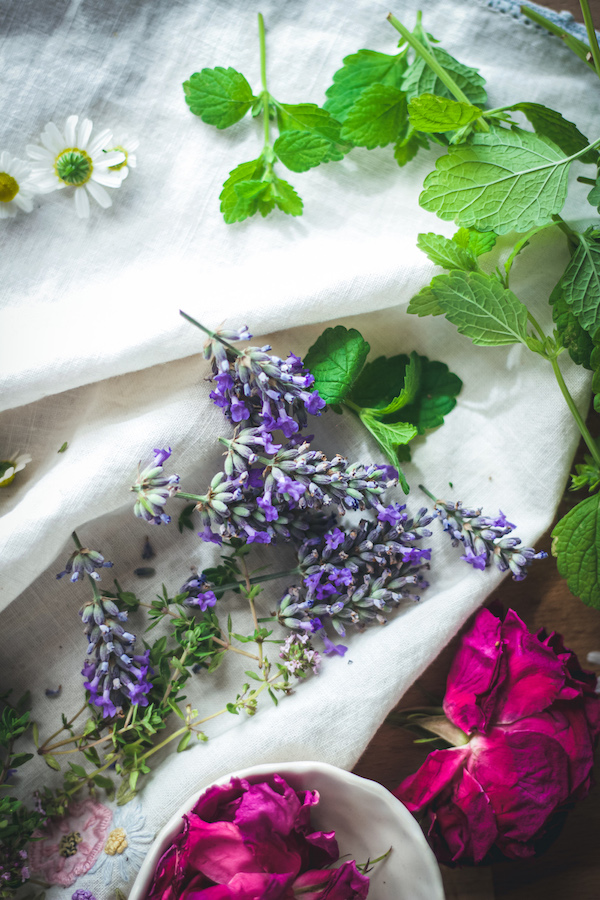
Venting herbs
Thyme and Hyssop are here for more than their fragrances and their anti-microbial activities. They both are herbs that from a Chinese medicine perspective “Release the Exterior”. These herbs are often aromatic and because of their energetics, float upwards through the Lung or Bladder median to open the pores on the head, neck or upper body to expel waste, or in the case of illness pathology, pathogens.
Some of the herbs in this category are diaphoretics. It is true that you would get more of a therapeutic action if you were to drink the tea of these herbs or take an herbal bath with them, but they still have this pore-opening effect when applied topically. Other notable herbs to chose from are Yarrow and Elder flower.
Other herbs in this formula, like Rose for example, are astringent and sour which work to shut the pores. The vinegar does this very much. Together the different herbs balance the formula.
Supporting (and just because) herbs
Melissa aka Lemon Balm, Roman Chamomile and scented Geranium all add depth of fragrance and have skin soothing properties of their own.
You can put any of your favorite herbs in here. What herbs do you love? Mint, Rosemary, Sage, Lemon Peel? Fir tips, Cedar, Witch Hazel?
I love Roman Chamomile essential oil, it’s one of the eo’s I still use, albeit on rare occasion. I love the smell of the herb as well and planted a patch in my garden this year, so I decided to try it topically in this formula.
Have you made your own Queen of Hungary Water?
I’d love to hear how you make yours, and how you like to use it.
Take good care of your face – if you feel so inspired to – most importantly you and yours.
Best plant wishes,
Celia
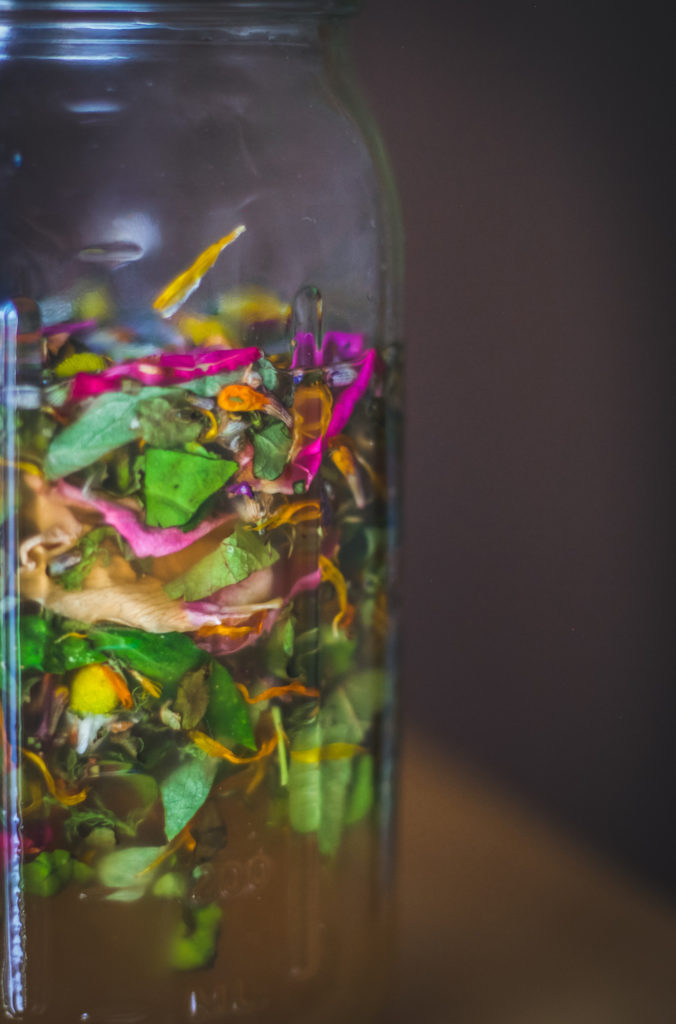
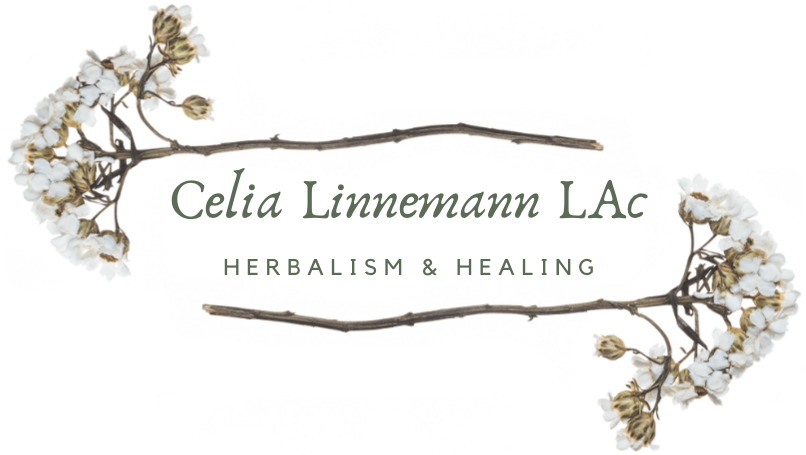
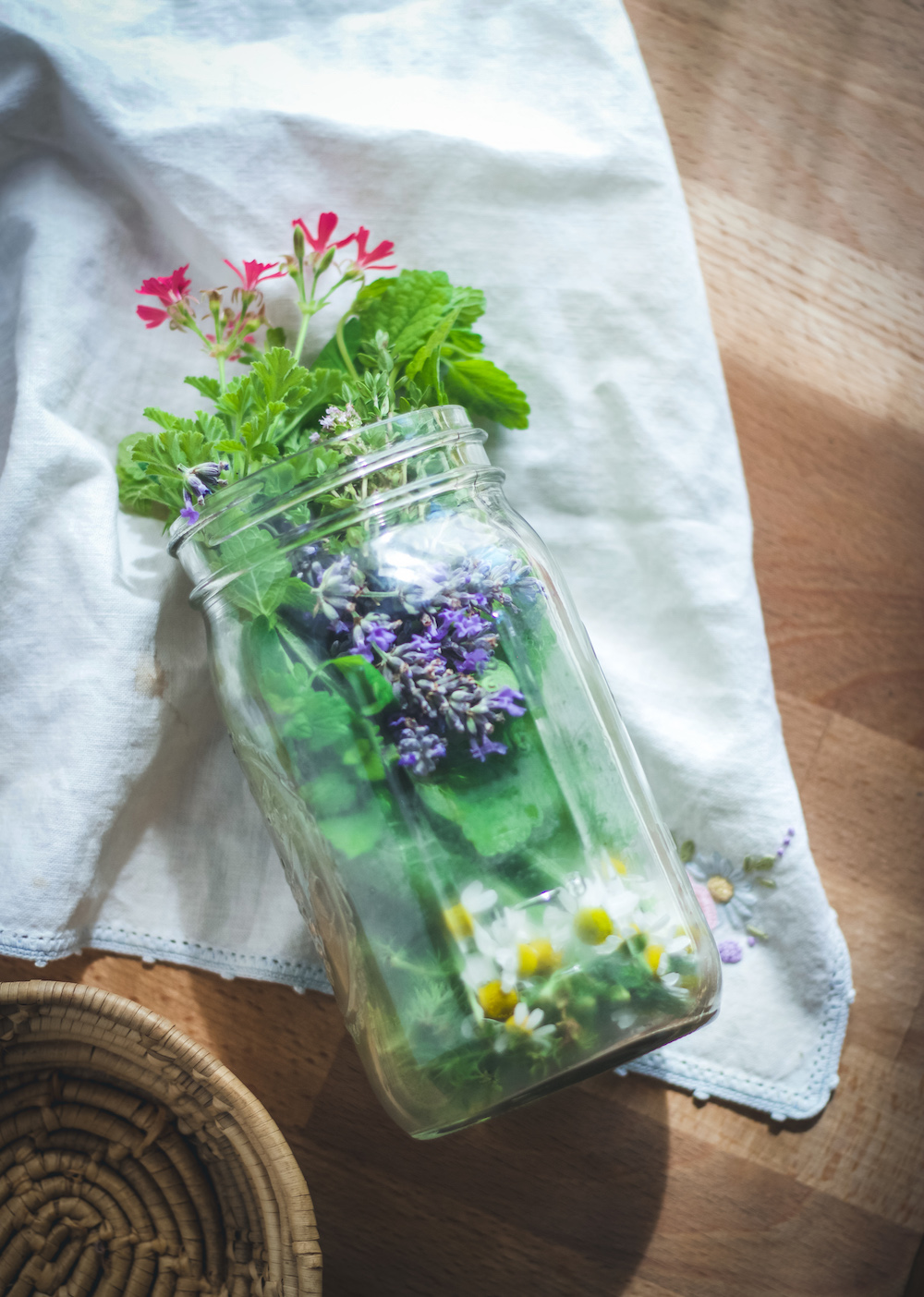





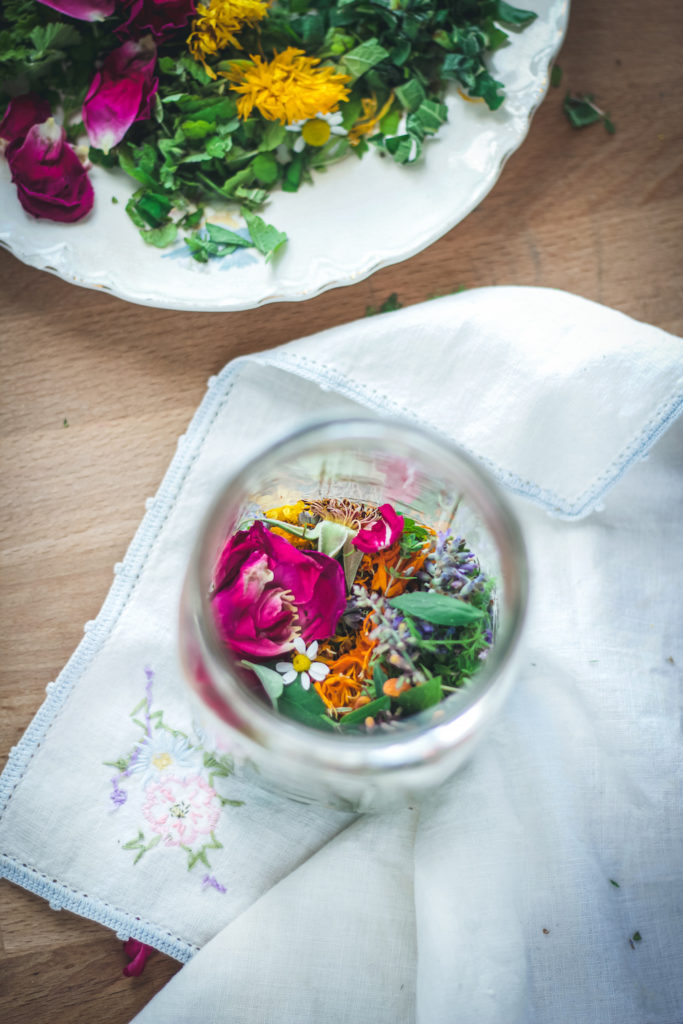
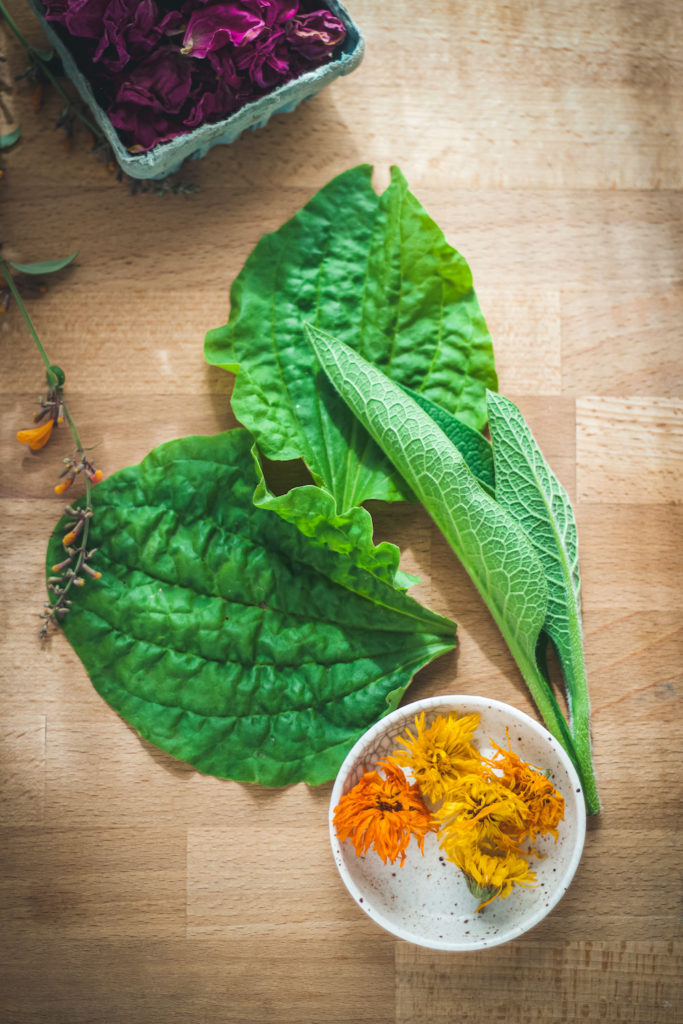






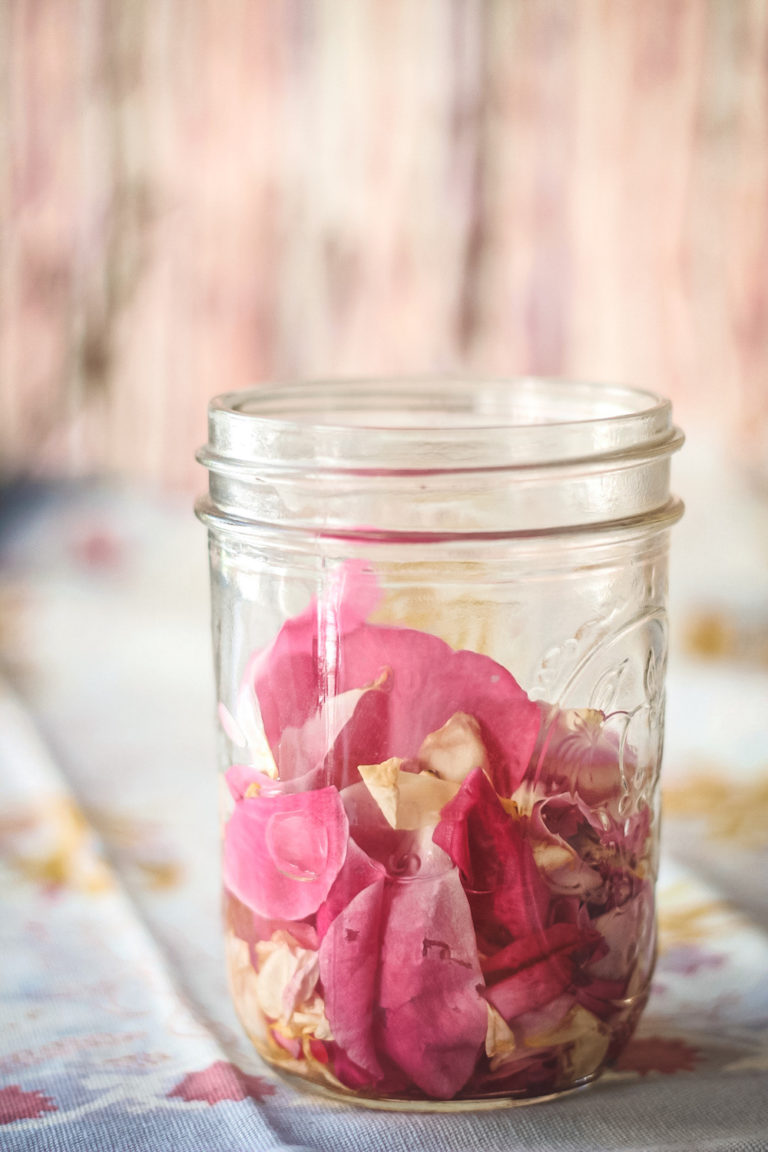



2 Comments